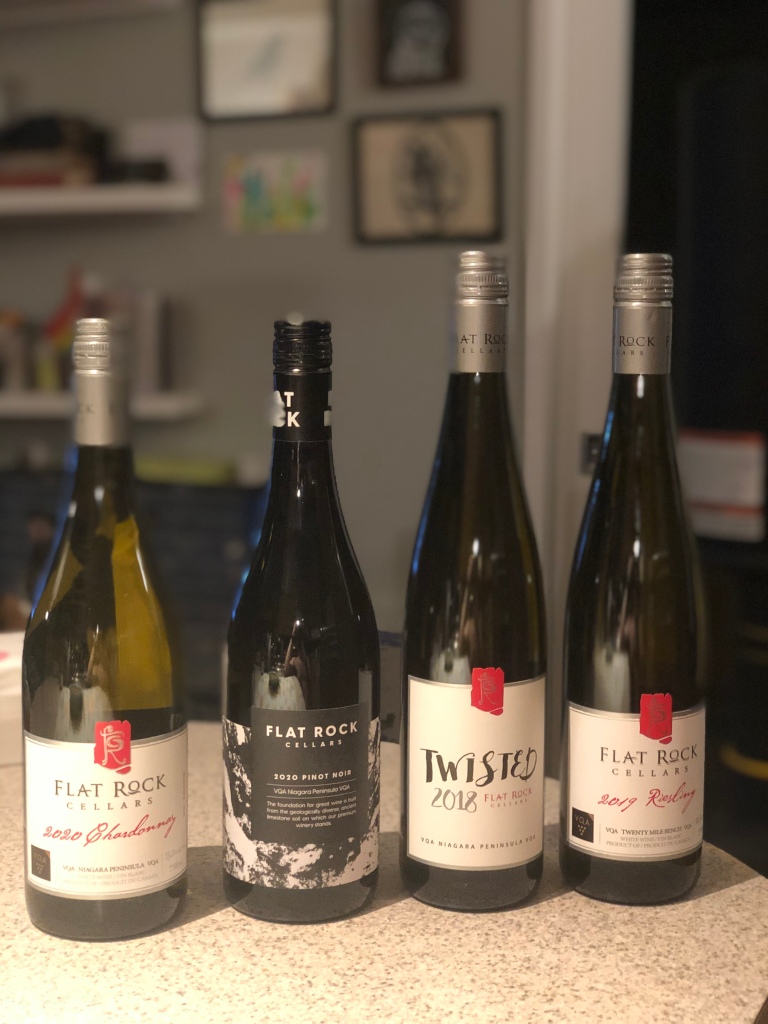By Raymond Lamontagne
[These bottles were provided as samples for review purposes.]
I almost literally jumped at this opportunity to blog an Ontario winery. Although I’m a western boy born and raised, and therefore somewhat imbued with the trappings of a “friendly rivalry” with all things associated with the centre of the Canadian universe, I do have some roots in the province. Trips out to see my wonderful in-laws have solidified a curiosity around Ontario wines, if not a budding passion that has so far survived some edifying (if not exactly lovely) experiences with bargain-priced local bottlings made from hybrid grapes. Add in the fact that the Alberta market is saturated with wines from our climate-change-plagued neighbour to the west, and I’m always looking for something different from our home country’s wine scene. Enter Flat Rock Cellars, a technologically proficient yet philosophically irreverent winery nestled within the confines of Ontario’s Twenty Mile Bench.

The Twenty Mile Bench is one of ten sub-appellations of the greater Niagara Peninsula region, a large area so diverse as to defy ready generalizations apart from the climate-moderating effects of Lake Ontario. More than half of Ontario’s VQA wineries fall within this overarching boundary. Fortunately we can provide more focused and useful characterizations of the smaller sub-appellations, and the Twenty Mile Bench provides an illuminating example of what Ontario can do with cool climate varieties. The area is a complex checkerboard of small, moderately steep slopes at high overall elevation, which affords relatively long periods of sun exposure. Breezes off the lake serve to circulate warm air, extending daytime temperatures into the evening. This provides ideal ripening conditions for high-acid cool climate varieties.
The soils here are predominately clay with a liberal dose of limestone, with a solid capacity to retain moisture that can mitigate the worst effects of drought. These are excellent soils for stress-prone mature vines. Some accomplished sommeliers propose that deep clays can lend a pronounced fruitiness to the resulting wines, while limestone lends a razor edge of acidity. Although I am leery of such umbrella proclamations even as I enjoy digesting them, these broad brush strokes around terroir make me wonder about the potential for a glorious balance in well-made Twenty Mile Bench wines: structured and fresh yet fruity, precise and pixelated yet pleasurable. Flat Rock Cellars seems poised to deliver on such a promise.
Ed Madronich Sr. founded Flat Rock Cellars about 40 years ago, and ultimately partnered with his son (also named Ed) to turn estate-grown grapes into wines of place. Their belief is that Chardonnay, Pinot Noir and Riesling are the classic varieties best suited to the Twenty Mile Bench’s relatively cool climes. Winemaker Allison Findlay and Canadian Burgundian-variety-pioneer-turned-part-time-consultant David Sheppard seamlessly blend state-of-the-art winemaking science and an artistic, creative flair to make their wines a reality. Flat Rock’s website is imbued with clearly explained technical details and brief flourishes of saucy humour in approximately equal measure, and the overarching gestalt is one that seems to work well for a boutique winery that has grown a bit beyond that label, albeit without compromising its core values. In “The Wines of Canada”, Rod Phillips explains that the winery’s name comes from the extremely stony vineyard soil that forces the vines to push their roots down deep, which Ed Jr. claims adds complexity to the wines. Let’s drink, shall we?
2018 Flat Rock Cellars Twisted White (~$23)
We begin with what I expect to be the most accessible and cheerful offering of the four wines reviewed here. Sure enough, Flat Rock describes the “Twisted” line of bottlings as “all about making serious stuff and injecting a sense of fun and enthusiasm”. In 2004, the winemaking team decided that it might be enjoyable to bend or break the classic rules of Burgundian winemaking, focusing instead on yielding something “dangerously drinkable”. The Twisted White is noted on the website to be the winery’s “top seller”. The exact blend composition changes yearly as a function of what grapes are available, although Riesling, Chardonnay and Gewürztraminer (a fourth variety featured in smaller doses at the winery) are always the building blocks. As one might expect for a crisp, crushable aromatic white, the juice sees only stainless steel. The 2018 vintage is 80% Riesling, 10% Chardonnay, and 10% Gewürztraminer. This leads me to expect something predominately characterized by that classic steely green apple-esque core of Riesling acidity, perhaps with a touch more fat than expected from the Chard and a discernable dose of wonderfully histrionic Gewürztraminer aromatics. 10% of the blend is typically enough for this distinctive and polarizing grape to make its presence known.

Sure enough, I immediately grasp those telltale signs of rose-scented Turkish delight and lychee, elderflower and honeyed cantaloupe. One can certainly smell the Gewürztraminer right off the bat. This honeyed vibe melds seamlessly into Golden Delicious apples and key lime pie, Bartlett pears and grapefruit blossom. On the palate this features a tangy powder-like Lemon Zinger tea-like acidity coupled with a fresh snap that constitutes a near-ideal fruity split between citrus and apple: the wine itself is far from perfect, but the way the aromas blend together so seamlessly supports this mix of grapes that initially appears almost random. No clear winemaking rationale or theory points toward mixing Chardonnay and Riesling to obtain a desired result, and a rather incongruous earthy rain barrel note sticks out like a sore thumb to me here when I go looking for it, but this is nevertheless more than a little pleasurable. If the goal was to chuck all the estate grown whites into a moderately raucous party in a bottle, mission accomplished.
88+ points
2019 Flat Rock Cellars Riesling (~$24)
Riesling requires the Flat Rock team to be particularly attentive to timing in the vineyard. The naturally late-ripening, high acid variety requires enough time on the vine to develop the appropriate aromas, but not so much that the grapes lose the acidity that provides needed freshness and precision. Flat Rock does a single vineyard offering, but here we investigate the stainless-steel-fermented entry-level estate bottling. Many Canadian Rieslings are bottled off-dry, presumably to cut the searing acidity, and this one is no exception at 25 g/L of residual sugar. I predict that the 10 g/L of acid will more than balance the sweetness, and Flat Rock’s Rieslings are renowned for a purity of fruit aromas. Sounds like a win.

The screw cap comes off with an assertive pop. I’m greeted with a few of the classic off-kilter textile-type notes I’ve grown to love in Riesling: fresh tennis balls, new carpet, maybe a little sandpaper. Delightful. The nose is delicate and rather subdued initially, although a bright tangerine halo burgeons beneath a surprisingly complex albeit spritely and ephemeral matrix of jasmine blossoms, white pepper, basil leaves, and acacia buds. My mind registers more aromatic layers than expected. My palate picks up on that tangerine from the nose, along with a further juicy blast of lemon and lime rind, Granny Smith, a dash of green mango powder (amchoor), and some further nectarine and guava elements that just begin to speak to rather sunny climes. The pulsing acidity would be bludgeoning (in a good way) if it wasn’t expertly balanced by that residual sugar. Lip smacking, with a slight fuzziness marring those clean lines just enough. I’d best investigate that single vineyard option.
90- points
2020 Flat Rock Cellars Chardonnay (~$26)
Chardonnay remains darling yet derisive, pervasive yet derided, atavistic yet cutting edge. Perhaps all these paradoxes can ultimately be chalked up to Chardonnay still being one of most popular and widely planted white wine varieties the world over despite actual movements forming to try to steer people away from it. This grape can be almost anything in the glass, depending on growing conditions and the winemaking techniques used. There has been a broad shift away from making highly oaked buttery styles in favour of freshly chiselled high acid greyhounds, a trend I largely support (even if I do indulge in the occasional butter-bomb guilty pleasure). Chardonnay is Ontario’s most planted white variety, and there has been a strong emphasis on cool climate renditions.
The back label of this bottle is well worth your time. It is basically a tongue-in-cheek (or is it?) rant about a “last ditch effort” to sell the Ontario wine-buying public on the contents, which are described as being rather Burgundy-esque albeit with a much better price tag. Sandstone-heavy soils provide good drainage, such that the grapevines require deep roots. This is thought to yield richness, and indeed there is a broad correlation between taxing the vine (at least to a point) and grape quality. There is also an early diss in the blurb about over-oaking, even as the use of French oak fermentation and ageing are highlighted later in the same paragraph. There definitely is a difference between tasteful oak and something that tastes largely like creosote and dead scrub. Tell you what, interest piqued.
This emerges a stately pale lemon hue, certainly looking the part of something tasteful and understated. The nose is a touch more decadent, however, flashing some ripe cantaloupe, kiwi, Golden Delicious apple, Asian pear and custard flan notes, only to have these largely wash back into the ether when one takes a sip. Only the Asian pear remains quite robust as lemon ice, yellow grapefruit and tree sap clamp down a bit on the tropical party. As billed, there’s a rather elusive richness that one can never entirely escape, albeit one finely burnished with a vinous Hades halo of smoky oak ghosts. Not much butter to be found, and the acidity is quite piquant for a barrel-aged wine, all jagged pineapple leaves and pointy brine-encrusted crags. I’m picking up what this is putting down, even if I want just a hair more body to match the nose.
89- points
2020 Flat Rock Cellars Pinot Noir (~$30)
Unlike the ubiquitous Chardonnay, Pinot Noir only narrowly cracks the top 10 of Ontario’s most planted grape varieties, although I would not have guessed this based on a quick scan of an LCBO shelf. Pinot sells, and so winemakers feel compelled to try their hand at it, even though Ontario’s winemaking regions as a whole fall dead centre (from a latitude perspective) in the world’s winemaking belt. This means that on paper Ontario may not be ideal for the cool climate variety, with warmer conditions often obliterating the grape’s signature finesse and intricacies. However, as noted above, the Niagara Peninsula enjoys the considerable moderating influences of Lake Ontario, and one take is that the Twenty Mile Bench itself might afford the best Pinot Noir terroir in the province. Enter our last bottle featured here, one that enjoys the same Burgundian oak treatment as the previously described Chardonnay.

This feature’s final offering shows the expected handsome medium ruby in the glass. I find the nose oak-forward, particularly initially. It’s a touch muddled, but I begin to parse out ash tray and wood char, earthy health food store cola and smoky cranberries. Fortunately things begin to coalesce into well-extracted and slightly jammy red fruit (cherry, pomegranate syrup, ripe juicy strawberry), some black (plum skin), and ongoing echoes of menthol cigarette and railway ties. This is intense. It is curious how dark Canadian Pinot can skew at times. Although this will appeal to many, and justifiably so, I like a Pinot with less blurry lines. The high definition acidity and body are there, but the wood is ultimately a lot. That said, palates are also susceptible to the vagaries of mood and situational context, and I liked this enough to be more than willing to revisit.
87+ points




Leave a comment